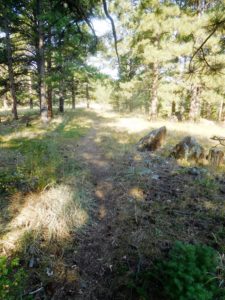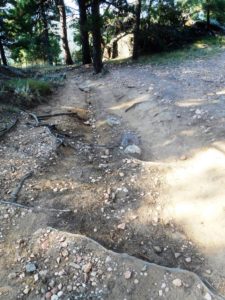Above: Bicycle damage to a once-pristine footpath in a JeffCo park
This article first appeared in Complete Colorado.
Advocates of government action often complain of “market failure.” Market failure occurs when obstacles prevent the market from offering the optimal quantity of certain goods and services.
Market failure is a major justification for government ownership of parks. In theory, parks could be provided by the private sector and paid for by users. But, the argument goes, the market cannot provide as many parks as people want, exclusion for non-payment can be difficult, and some park values—such as environmental protection—are hard to monetize.
However, there is also a phenomenon economists call government failure. It means that governments, as well as the market, can screw up. Symptoms of government failure include shortages, overuse, and abusive and inefficient use of resources. Reasons for government failure may include political pressures, bureaucratic inefficiency, and poor incentives. Moreover, government usually does not price goods and services properly, so managers often have poor information about supply, demand, and public preferences. If you’d like to see a good example of government failure, visit the trails in most Denver-area mountain parks.
Coloradans acquired our mountain parks for environmental purposes and for low-impact uses such as hiking, picnicking, back-country tent camping, horseback riding, nature study, and in some cases, fishing or hunting. Coloradans did not acquire them as bicycle raceways. But that is what many of them have become.
White Ranch Park example
When I visited JeffCo’s White Ranch Park in the 1970s and 1980s, you walked or rode horseback into beautiful forest and forest meadows, and enjoyed spectacular views, and viewed and photographed plants and animals. The ambiance was quiet and vehicles—other than rare maintenance vehicles—were absent.
Today, the experience at White Ranch—particularly, but not exclusively, on the weekends—is quite different. Trails are torn up. Wildlife is rare. Nature’s sounds are replaced by “woops” from cyclists and “music” from their electronic devices. The unmounted trail user is subject to constant interruption and sometimes to physical danger.
White Ranch is only one of the casualties. A sharp increase in Colorado mountain biking, caused partly by population rise but primarily by new bike technology, caused cyclists to flood the mountain parks. Administrators have failed to respond effectively (including when I’ve spoken to them). Indeed, in some instances—possibly under pressure from the user-retailer biking lobby—they cater to cyclists over others.
And so, bicycles now dominate many of our front-range mountain parks, largely displacing the uses for which those preserves were designed.
Why is that a problem?
It’s not because mountain biking is a bad sport or that cyclists are bad people. On the contrary it is a great sport (which I used to practice) and most cyclists are very good people.
It’s because administrators have failed to recognize that some uses are fundamentally inconsistent with others. Although they keep motor vehicles off bike paths, they give bicycles unrestricted access to sensitive footpaths.
By “sensitive” I mean this: Most mountain park trails (there are exceptions) were conceived and constructed as footpaths. In fact, many—such as those built by the Colorado Mountain Club—were designed by hikers for hikers. They are often narrow and curved and serve steep terrain. They wander through wildlife habitat, pine and aspen groves, and striking scenery. Allowing unrestricted bicycle use on trails of this nature creates harm in at least four ways:
First: Bicycle traffic causes trail damage, especially in steep and wet areas. Cyclists leave the trail to pass hikers and other obstacles, thereby trampling nearby vegetation. They carve hollows in trail banks so they can sweep around curves at high rates of speed. When they struggle uphill, they let their front wheels wander outside the path.
Second: Most mountain park trails are narrow and curved in ways that limit visibility because they were designed for ambulatory use. But bicycles, unlike people or horses, are vehicles. While a typical hiker or equestrian travels 2-4 miles per hour, a downhill cyclist may exceed 20 miles per hour.
Not only is there a great velocity differential between bikes and pedestrians, but there is an even greater momentum differential, because mounted bicycles are more massive than pedestrians. (Momentum is the product of mass and velocity.) I should add that bikes also have sharp edges. People can get hurt very badly.

in good condition
White Ranch Park trail after intensive bicycle use
Third: Bicycle use of mountain trails impairs other values. Hikers and equestrians take to the trail, at least in part, for the peace it brings: feeling the sun and wind; listening to the sounds of the forest; enjoying wildlife, plant life, and scenery; viewing water and geological formations; or merely falling into reverie. But those values are far from the motivations of most bikers: As almost universally practiced on the Front Range, mountain biking is a fast, high-energy, high impact—and often noisy—sport.
There are few events more damaging to a hike than fast-moving vehicles tearing past you, forcing you to jump out of the way, frightening you from behind, and sometimes endangering you.
Finally, mountain biking rests uncomfortably with a core mission of the parks: access to wildlife, natural beauty, and other environmental values. For many cyclists, of course, that is not a problem: Rather than studying their surroundings, they are either pumping uphill or racing downhill.
Before going further, I need re-emphasize something: The basic problem here is not “bad bikers.” The problem is that while cycling is a very good thing in some locations, it is not a good thing at many of our mountain parks. As U.S. Supreme Court Justice George Sutherland famously observed, “A nuisance may be merely a right thing in the wrong place, —like a pig in the parlor instead of the barnyard.”
What to do
Here are some suggested solutions:
* Implement more widely the Roxborough State Park model for bicycles: Cyclists are welcome to ride their vehicles to the park and travel on the main roads. But if they wish to use the mountain trails, they must do so on foot or horseback. (In fact, Roxborough even bars equestrians, which is unnecessary at most parks.)
I believe this model should be adopted for several JeffCo parks, including the Mayhem Gulch area. I think it is imperative for Golden Gate Canyon State Park, where the trails are particularly steep and the high mountain environment particularly sensitive.
* Where there are vehicle service roads, as at Staunton State Park, they can be opened to bicycles exclusive of hikers.
* Most cyclists aren’t into the sport for the environmental values, so parks with marginal environmental values—such as JeffCo’s Hildebrand Ranch—could be “biker only.” Park staffers and volunteers could construct ramps, obstacles, and other improvements of interest to bikers.
* Administrators should implement more widely one decision that JeffCo got right: On weekends at Centennial Cone, even-numbered weekend days are limited to bikes while odd numbered days are limited to hikers. This system should be implemented for all days at Apex Park, which is a favorite of cyclists but whose narrow trails make them dangerous and disruptive to hikers. I think the pattern also would make sense at Deer Creek Canyon and Alderfer/Three Sisters.
* In some parks—such as Staunton, Mt. Falcon, South Valley, and Deer Creek—administrators have adopted the nonsensical approach of making only part of a loop hiker only, so that hikers have to struggle through bicycles to get to the portions of the trail reserved for them. This should be changed so that parks offer complete loops to hikers. This is already done at JeffCo’s Reynolds Park and at Golden Gate Canyon and, approximately so, at the Denver Mountain Parks of Corwina and O’Fallon.
* Park administrators should get the pricing right. Cyclists, like hunters and fishermen, should pay for the costs of serving them. Although the state parks impose a modest user fee, JeffCo parks do not. JeffCo should impose user fees where appropriate, either on entry or by registering bicycles ridden on park land.
Finally: The mission of our state parks is to serve a wide and diverse public: all races, genders, and ethnicities; young, middle aged, and old; athletic, unathletic, and handicapped. By contrast, mountain bikers (with exceptions, of course) overwhelmingly represent a rather narrow demographic group—that is, athletic, millennial/Gen Z, white males.
There is nothing wrong, and everything right, with young, athletic white males. But our mountain parks can serve them in the same manner it serves the rest of the public: by providing awesome places to recreate in ways that do not disrupt other users or destroy the natural environment.









